79tka Insights
Your go-to source for the latest news and information.
Trade Up or Shut Up: Secrets of CS2 Trade-Ups You Never Knew
Unlock the hidden strategies of CS2 trade-ups! Discover secrets that could skyrocket your profits in our must-read guide!
Mastering CS2 Trade-Ups: Essential Tips and Strategies
Mastering CS2 Trade-Ups can significantly enhance your gaming experience and potentially increase your inventory's value. To begin with, it's essential to understand the mechanics behind trade-ups. Essentially, a trade-up contract allows players to exchange a certain number of lower-tier skins for a higher-tier one. Before diving in, familiarize yourself with the market trends using resources such as CSGOStash or CSGO Trade-Ups to track fluctuations in skin values and demand. Start with a budget and aim to collect skins that are not only visually appealing but also have good resale potential.
To maximize your chances of success, consider the following essential tips:
- Know Your Skins: Invest time in learning which skins have the highest trade-up potential and which ones are currently trending in the market.
- Calculate Risks: Use trade-up calculators to analyze the probability of getting valuable skins from your trade-ups.
- Stay Updated: Keep abreast of market changes and community trends, as they can dramatically affect skin values.
- Strategic Trading: Occasionally, it may be beneficial to hold onto certain skins instead of trading them up, especially if their value is expected to increase.
By following these strategies, you can navigate the complexities of CS2 trade-ups more effectively and enhance your overall gaming portfolio.

Counter-Strike is a popular team-based first-person shooter that has captured the attention of gamers worldwide. One of the many appealing aspects of the game is its wide array of skins and accessories, including unique items like tiger strike gloves, which allow players to customize their characters and enhance their gaming experience.
The Ultimate Guide to Understanding Trade-Up Contracts in CS2
The Trade-Up Contracts in CS2 offer players a unique opportunity to exchange their lower-tier weapon skins for a chance at higher-tier items. This process involves a strategic selection of skins, where players can trade up a set of skins to receive one new skin of a higher rarity. Understanding the mechanics behind these contracts is essential for making the most out of your inventory. Each contract allows you to choose ten skins of the same rarity; upon completion, you will receive one skin of a higher tier, which not only enhances your gameplay experience but also can increase the value of your inventory significantly.
To get started with Trade-Up Contracts, follow these simple steps:
- Gather ten skins of the same rarity.
- Navigate to the Trade-Up Contract section in CS2.
- Select the skins you wish to trade.
- Confirm the trade and watch as your new item emerges.
Is Your Trade-Up Strategy Worth It? Insights and Common Pitfalls
When it comes to evaluating trade-up strategies, it's crucial to assess whether the potential gains outweigh the risks involved. Thorough research and analysis should be conducted, keeping in mind factors such as market trends, pricing fluctuations, and the overall demand for the goods or services involved. A well-executed trade-up strategy can lead to significant profits, but without proper planning, it can also result in unnecessary losses. Here are some insights to consider:
- Analyze your current assets and their potential value.
- Research market trends to identify optimal timing for trades.
- Calculate the potential ROI to determine if the trade-up is worthwhile.
However, even the best trade-up strategies can falter due to common pitfalls. One of the most significant mistakes is skipping the due diligence phase, which can lead to poor decision-making. Additionally, failing to adapt to changing market conditions or overestimating the value of traded items can derail your strategy. It's essential to remain flexible and continuously evaluate your approach. Remember, a successful trade-up strategy requires not only a clear plan but also a willingness to learn from missteps:
"The best strategy is one that evolves with the market; stay informed and agile."